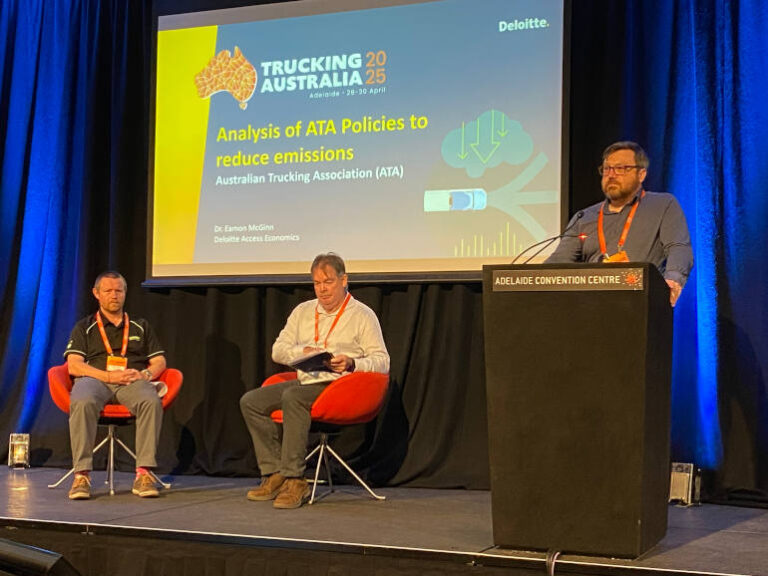As Australia moves toward its legislated 2050 net zero emissions target, fleet managers across all industries are asking a simple but pressing question: when will the right low-emissions technologies be ready for heavy vehicles?
According to detailed modelling presented by Eamon McGinn, a Partner at Deloitte Access Economics, at the 2025 ATA Conference in Adelaide, the answer is: not immediately — but there’s a clear window of opportunity emerging in the next 10 to 20 years. The implications for fleet managers in construction, mining, utilities, local government, and beyond are significant.
A Decade of Transition, Followed by Real Change
Deloitte’s analysis was based on the Australian Trucking Association’s (ATA) proposed policies to cut emissions from heavy vehicles — one of the largest users of diesel fuel in the country. Rather than making sweeping or speculative claims, Deloitte focused on practical, evidence-based projections that reflect real-world technology readiness and cost modelling.
Here’s what the data shows:
- Hydrogen-powered heavy vehicles will not reach commercial maturity or cost competitiveness until the 2040s.
- Renewable diesel, as a “drop-in” fuel that works in existing diesel engines, will become widely available around 2036, with a modest but important 5% blend proposed in the ATA platform.
- In the meantime, electric trucks — particularly rigid urban trucks — will begin to scale from 2026, supported by proposed government incentives to address high upfront costs.
This sets a clear trajectory for fleet emissions planning: focus on urban electric trucks in the short term, begin introducing renewable diesel in the medium term, and prepare for hydrogen vehicles as a long-term solution.
Hydrogen: The Long Game
Hydrogen has long been touted as the answer for long-haul freight — offering the range and refuelling speed of diesel, without the tailpipe emissions. However, Deloitte’s modelling, based on projections from CSIRO and AEMO, indicates that hydrogen won’t scale in transport until after 2040.
The reason? Cost and infrastructure.
Hydrogen trucks are expected to remain prohibitively expensive for the next 15 years, and Australia currently lacks the refuelling infrastructure to support them at scale. Production of green hydrogen — which uses renewable electricity to split water — is also energy-intensive and not yet cost-competitive.
This means fleet managers shouldn’t plan to rely on hydrogen before 2040 unless they are part of a pilot program or a major project with vertically integrated supply chains.
However, by the 2040s, Deloitte anticipates a technology tipping point. As global investment in hydrogen ramps up and the cost of production falls, hydrogen fuel-cell vehicles are expected to become increasingly viable — especially for high-tonnage, long-haul operations where batteries are less practical.
Renewable Diesel: The Bridging Fuel
In contrast, renewable diesel (particularly Hydrotreated Vegetable Oil, or HVO) is ready sooner — and in many cases, today. It’s a chemically similar alternative to fossil diesel and can be used in existing engines with little to no modification. However, wide-scale supply and cost competitiveness are the barriers.
Deloitte’s modelling assumes a 5% renewable diesel blend introduced from 2036, in line with the ATA’s recommendations. This would deliver a 7 million tonne reduction in CO₂ emissions over 25 years — with most of the benefit concentrated in the articulated truck fleet that is otherwise slow to electrify.
But why wait until 2036?
As fuel expert John Oxley from BP explained at the conference, while renewable diesel is already technically available, Australia currently exports much of its feedstock and lacks domestic production capacity. BP’s proposed plant in Kwinana is still years from reality, and blending renewable diesel into the fuel mix will depend on regulatory settings, international markets, and customer demand.
Cost is another factor. Renewable diesel remains 2–3 times more expensive than fossil diesel — a premium that few operators can absorb without government support or emissions-related compliance requirements. Over time, as production scales and policies evolve, price parity may become achievable — but fleet managers should not count on this before the mid-2030s.
Electric Trucks: Urban First Movers
In the meantime, Deloitte’s modelling shows that battery electric rigid trucks are the most realistic early adopter technology. A proposed voucher scheme, by the ATA, offering a 50% subsidy on the price difference between diesel and electric trucks could bring electrification forward by five to six years — with electric rigid trucks reaching 20% market share by the early 2030s.
These vehicles are most suited to stop-start urban delivery work, depot-based fleets, and councils — especially where overnight charging is available. Articulated trucks, by contrast, are likely to lag due to high cost and range limitations.
What Does This Mean for Fleet Managers?
If the trucking industry — as a group, one of the largest purchases of diesel in Australia — is working to a 2036–2040 timeline for renewable fuels and hydrogen, other industries should take note.
Local government, mining, construction, and utilities should use this modelling to guide their fleet emissions strategies. Here’s what to consider:
- Short term (2025–2030): Prioritise electrification of light and medium-duty vehicles, especially in urban or depot-based applications. Avoid investing in diesel-only platforms where electric options exist.
- Medium term (2030–2040): Plan to trial and integrate renewable diesel in existing heavy vehicle fleets. This is particularly useful where EVs are not yet viable. Expect blended fuels and supply constraints until local production increases.
- Long term (2040+): Develop a roadmap for hydrogen adoption in long-haul, high-utilisation vehicles. Engage with OEMs and industry partners early to understand compatibility, infrastructure, and operational impacts.
Final Thoughts
The takeaway from Deloitte’s modelling is not to wait — but to sequence the transition. Fleet managers must take an active role in emissions reduction now, even if zero-emissions heavy vehicle solutions are still a decade or more away.
Understanding when each technology will realistically come online — and at what cost — is essential for strategic fleet planning. Because decarbonisation isn’t just about waiting for the perfect fuel — it’s about making the right move at the right time.






